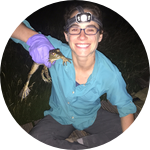About This Project
We are developing better population models for amphibian conservation on the Buenos Aires National Wildlife Refuge, Arizona, USA. Our research is focused on developing statistical models to predict the most effective management actions for these species. Results from our analyses will be used by managers to implement the most effective conservation plans. As part of this project, we are building educational displays to teach refuge visitors about amphibian conservation.
Ask the Scientists
Join The DiscussionWhat is the context of this research?
Several amphibian species currently live within the Buenos Aires National Wildlife Refuge (BANWR), Arizona (USA), however the future of these species is uncertain. Numerous factors including climate change, invasive species, and direct disturbance by humans (e.g., road mortality) may elevate extinction risk and threaten the long-term viability of these animals. In collaboration with the BANWR, we are working on developing population viability models to quantify the influence of specific management and climate/land use change scenarios on colonization and extinction dynamics of desert-dwelling amphibians.
What is the significance of this project?
An important component of our project is gaining insights into the population dynamics of desert-dwelling amphibians, many of which we know very little about. However, developing truly effective management tools necessitates collaborating with refuge managers to outline management alternatives (e.g., habitat restoration, reduction in road mortality through visitor education) and the constraints (e.g., time, money, manpower) associated with each action. Through collaboration with researchers and refuge staff, our project will result in more effective management tools that can be used to 1) implement conservation actions and 2) evaluate those actions, after they have been taken.
What are the goals of the project?
We have already developed statistical models to describe the population dynamics of one species on the refuge, the federally-threatened Chiricahua leopard frog. However, these models are descriptive and do not yet project population dynamics into the future. Our overarching goal is to better inform conservation efforts by incorporating the financial and logistical constraints of specific management actions into our estimation of extinction risk under various climate and landscape change scenarios. Additional, we are working on adapting our single-species models to predict the population dynamics of multiple, interacting species within the amphibian community.
Budget
Visitors to the refuge encounter a diversity of wildlife, including birds, mammals, reptiles and amphibians. One major source of mortality, particularly to the less visible and less mobile amphibians, is being run over by vehicles. Currently there are no informational displays for visitors regarding amphibian species. As an immediate goal of reducing vehicle mortality, educational displays on the main road into the refuge warning of the potential for amphibian road crossings may reduce vehicle-induced mortality. A more long-term goal of educating refuge visitors regarding the importance of amphibians for food webs and ecosystem function can also be addressed with simple, yet informative signage on refuge roads. This effort is part of our larger project goal of preserving desert amphibians through a variety of conservation actions, including habitat restoration and public outreach, and education.
Endorsed by
Meet the Team
Paige Howell
Currently, I am a PhD student at the University of Georgia in Athens, GA, USA. Prior to that I completed my bachelor's degree in Biology at Kalamazoo College, Kalamazoo, MI and a Masters in Zoology at Michigan State University, East Lansing, MI.
My dissertation research is focused on building statistical models that integrate what we know about how a biological system works with the management actions available and the constraints, including cost and time, that accompany those actions. Working as a team with researchers and managers we can develop better models for conservation that allow us to predict the efficacy of specific management alternatives and evaluate those actions after they have been implemented.
Lab Notes
Nothing posted yet.
Project Backers
- 4Backers
- 3%Funded
- $24Total Donations
- $6.00Average Donation

